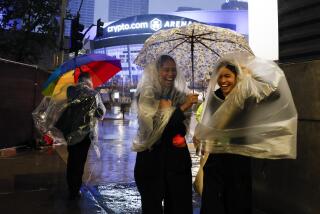Editorial: Drought is the new normal. We need less shaming and more incentivizing
It was a rainy weekend in Southern California, but there have been too few such storms in what had been expected to be a rain-soaked El Niño season. This fifth straight year of drought is further evidence that this may not be a drought at all but a return to a dry norm. Our state may have been built and populated during a rare and narrow, century-long period of unusually wet weather; or it may be that human-induced climate change has altered rainfall patterns and permanently diverted much of the snow that used to fall in the Sierra and much of the rain that used to fall here to points farther north and east. But our thirsty living patterns remain geared to wetter days that are vanishing, and to artificially abundant water.
So how do we move forward in a drier era? How do we continue to quench our thirst sufficiently, prudently and fairly?
Most proposed paths begin responsibly enough, with a new conservation ethic and an arid region’s respect for water as a scarce and precious resource that must not be squandered. In Los Angeles, government has been constructive in supporting that ethic with programs to require more efficient fixtures indoors and more California-oriented plants and landscaping outdoors. It has slowly but finally begun to catch up with people who want to be more water-wise, by rewriting rules that once made it nearly impossible to, for example, reuse washing machine and bath water in the garden.
But farther on, the path through the arid future branches, and one route takes us into a phenomenon that has come to be known as drought-shaming.
Drought-shaming describes a system in which neighbors become snitches and government workers become water cops. It’s a culture of resentment, envy and suspicion, of demands for prosecution and penalties, in which residents with brown yards seethe over the lush green lawns down the street, or even over stories of unseen lawns, like the one belonging to that guy (or family, or company, or whatever) in Bel Air who uses as much water as 90 houses, or, farther afield, like the Saudis who grow thirsty alfalfa down by the Colorado River in order to export it, or the hedge funds that pay farmers to plant almond trees in the desert-like West San Joaquin Valley in order to sell products that most of us never heard of a decade ago, like almond milk. It’s the kind of culture in which Sacramento residents who have recently been required to install water meters bristle over video of some guy in Orange County hosing down his driveway.
Much of the drought-shaming culture makes perfect sense — in a drought. That’s because a drought is by definition a temporary departure from the accustomed abundance. It is a crisis that calls for a crisis response, just like an oil embargo once required gasoline rationing or war once meant limits on how much beef or milk a family could buy each week. Rules are drawn up to get society through the temporary shortage. Cheaters emerge. Some prosper, others are caught. But at some point we get back to normal.
When the crisis continues, though, it ceases to be crisis and becomes a new reality requiring new living patterns. Drivers choose cars that use less gas, or none at all. Families choose different foods. Prices adjust, and people make decisions accordingly.
That may be where California is, or ought to be, with water. Penalizing wasters is a drought response, which is fine as far as it goes. But to meet the future, Californians’ water ought to be priced in a way that incentivizes the Wet Prince of Bel Air to use it prudently — and reimburses the rest of us for the cost of replacing the water that he used.
L.A.’s Board of Water and Power Commissioners recently approved a schedule of water waste fines, and it will soon come before the City Council. Together with new pricing tiers that encourage conservation while keeping sufficient low-priced water available for common household needs, the fines are best seen as a thoughtful and appropriate measure for a time of transition from temporary drought to sustained aridity, rather than a new weapon for an era of drought-shaming. The City Council ought to approve them — and then rededicate itself to projects to capture and reuse storm water and waste water, to quench the city’s thirst in a future with little rain.
Follow the Opinion section on Twitter @latimesopinion and Facebook
More to Read
A cure for the common opinion
Get thought-provoking perspectives with our weekly newsletter.
You may occasionally receive promotional content from the Los Angeles Times.










